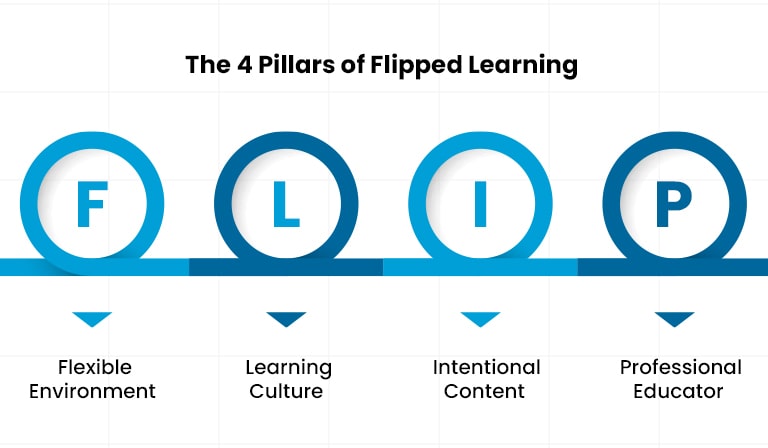The Art of Flipped Learning Unveiled: Part 1
Over time, teaching and learning methods have undergone significant transformations to adapt to the needs of today’s generation of students. The rise of the internet and technology has transformed classrooms, creating a more interactive and results-oriented approach to learning. One such effective teaching methodology that has gained popularity is the concept of flipped learning, wherein educators deliver lessons to learners in the “outside-the-class” environment. This approach has proven particularly valuable during the pandemic, as many educational institutions embraced flipped classrooms to ensure continued learning.
Through this innovative strategy, learners are empowered to grasp the practical application of concepts and delve deeper into complex subjects. By engaging with the material outside of traditional classroom hours, students can gain a more profound understanding of the topics at hand. As a result, flipped learning has become a powerful tool to enhance the overall learning experience and better prepare students for the modern working landscape.
What is Flipped Learning?
Flipped learning is taking the education world by storm, captivating higher and secondary education students alike. The concept is simple yet transformative: students dive into online classes, lectures, and courses as homework, paving the way for interactive in-person sessions.
Instead of passively absorbing information during lectures, students actively engage in dynamic discussions, collaborate on projects, ask thought-provoking questions, solve problems, think critically, and even take turns teaching the class in a flipped lesson. It’s a refreshing departure from the traditional model, redefining how knowledge is acquired and making learning an exciting journey.
What are the four pillars that ensure flipped learning’s success?

Flexible Environment: Students have the power to choose when and where they learn. No more rigid schedules; learning becomes a personal and adaptable journey in flipped lessons. Additionally, educators understand that every student has different needs, making assignments and deadlines flexible to accommodate individual growth.
Learning Culture: Farewell to the era of one-way information flow! Flipped learning shifts the focus from lecturers to learners. In-class time becomes an exploration of the knowledge gained from digital resources, nurturing active involvement and empowering students to construct their understanding actively.
Intentional Content: Flipped learning is all about conceptual understanding and procedural fluency. Educators thoughtfully curate content to enhance the learning experience, guiding students through the subject matter while encouraging active participation.
Professional Educator: The heart of the flipped classroom model lies in the hands of professional and experienced educators. They provide valuable feedback, observe student progress, and facilitate a collaborative and engaging learning environment. Though they step back slightly, their role in orchestrating the flipped classes remains crucial.
Does flipped learning actually work?
Studies back the effectiveness of flipped classrooms, demonstrating significant academic gains compared to traditional setups. Students flourish in flipped classes, developing higher-order thinking skills and expanding their academic and professional capabilities. Moreover, they sharpen their time management, interpersonal, and intrapersonal skills, preparing them for success in all aspects of life.
Have a look at some thought-provoking statistics on flipped classroom model:
- The method of flipping lessons received a recommendation from 96% of teachers who have tried it.
- Among the researched teachers, 46% have been teaching for more than 16 years but are now embracing flipped classrooms.
- After adopting the flipped classroom approach, 9 out of 10 teachers reported a positive change in student engagement.
- Since implementing the flipped classroom strategy, 71% of teachers have seen an improvement in their students’ grades.
Flipped learning truly shines in skill-based curricula and STEM courses, where it leads to even greater student achievements. Embrace the future of education! Flipped learning is a powerful tool that unlocks a world of active engagement, deeper understanding, and endless possibilities.
The Möbius Platform: Foster a Seamless Flipped Learning Environment
The Interactive Möbius platform, by DigitalEd, provides multiple pathways to flip a classroom for students. Educators and universities can leverage this dynamic platform to deliver flipped lessons and enrich the entire learning experience.
Role of Möbius in Flipped Learning:
- Design, develop, deploy, and distribute interactive digital course content to learners, providing maximum flexibility to research, learn, and understand the concepts before in-person classroom sessions.
- Apart from digital resources, learners can leverage a bottomless bank of randomized algorithmic questions to assess their own progress, creating an effective environment for self-evaluation.
- Include multimedia visualization to breathe life into complex STEM concepts and enhance overall learner comprehension. Also, create completely customizable digital course content to suit your student’s needs and capabilities.
- Educators are part of the entire learning process. Offer in-line questions in-between digital flipped lessons to precisely monitor individual students’ learning progress, identify knowledge gaps, and offer immediate feedback accordingly.
Want to explore the Möbius experience?
Click here to schedule an in-depth product demo session today!
And stay tuned for more articles in the Flipped Learning Series.
(Statistics source: LearnDash)